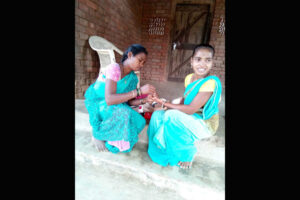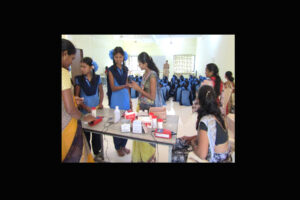Addressing Anemia in Mothers of Tomorrow
This program is in the Vikramgad talukas of the Palghar District which is north of Mumbai in the state of Maharashtra. In this area, 75% of the population is tribal (indigenous Adivasi) with a literacy rate of 37%. Many villages have no educational facilities within five to ten kilometers. Infant mortality rates are high, 84% of the villages do not have access to heath care within 5kms – 10km, only 12% of households have toilets, 65% of the working population is unemployed, which only exacerbates poverty levels.
Entire families, or working members, migrate between November and May to meet basic livelihood needs. This results in hardships for the old, the sick, and the children who are not only left behind, but are deprived of a basic education. The migrant separated from his family works in bad conditions, is exploited, becomes ill, and later, brings illnesses into the tribal community. About 35% of the children in this region are malnourished.
Project Location – Bhopoli Region •Palghar District • Maharashtra State • India
Executive Summary of Problem and Intervention: Very high prevalence of anemia in Adolescent girls and pregnant women. Major cause of malnourished children.
Our Strategy to Cure Anemia
-
Screen and treat anemia in adolescent girls, pregnant women, lactating mothers and children
-
Curative: Treat anemic girls with iron supplements, vitamins and homoeopathic medicines
-
Outreach & Education: Audio Visual media, Printed Literature, Practical Demonstration on Diet
Number of Beneficiaries – 1000 girls, 1300 women, 1300 children
Preventing Anemia in Mothers of tomorrow, prevents low birth weight babies and malnutrition at birth
-
- In 2019, Prevalence of Anemia in pregnant women was 36.5% world over.
- In India around the same time it was 52.2% ( Ref: NFHS: 5)
- In Maharashtra it was 47.5% in pregnant women
- The percentage is much higher in Rural Maharashtra and even higher in tribal areas.
- It was 57.5% in adolescent girls and a whooping 68.9% in children up to 5 years of age.
- In our intervention area around 50% pregnant women and adolescent girls are found to be anemic.
We need to understand the effect of anemia on the overall population to grasp the gravity of the problem.
- Anemia is associated with poor cognitive and motor development in children, and work capacity in adults, influencing country economic development.
- Among pregnant women, iron deficiency anemia is also associated with adverse reproductive outcomes such as preterm delivery, low-birth-weight infants, and decreased iron stores for the baby, which may lead to impaired development.
- Anemia is one of the contributing factors to Infant or maternal death.
- Failure to reduce anemia may result in women experiencing impaired health and quality of life.
To tackle this problem, the Government of India launched the Anaemia Mukt Bharat (AMB) strategy with the target to reduce anemia in vulnerable age groups such as women, children and adolescents in a life cycle approach providing preventive and curative mechanisms.
Following strategies complement government efforts.
Tackle adolescent anemia:
- Screening: Testing hemoglobin with digital instruments of girls between 15 and 16 years of age
- Treatment: With Iron supplements of anemic girls along with homeopathic treatment and monitoring for 2 years
- Continuous education and orientation to ensure behavior change and compliance to the intervention
- Creation of Audio-visuals, posters, brochures to spread the awareness of the entire community
Tackle Anemia during pregnancy:
Usually by 18 years of age they are already married and pregnant.
- During Pregnancy we continue the monitoring and Iron supplements
- This along with the intervention of adolescent girl, constitutes the proposed 1000 days of intervention of ‘Mothers’
- This will improve the Iron stores and will reduce the burden of anemia in Mothers.
- We also give homeopathic medicines as adjuvant therapy.
Tackle anemia in lactating mothers for initial 6 months
Mothers give exclusive breast feed to their babies for initial 6 months. They need to have good iron stores so that the babies gain weight not at the expense of the mother.
- Education, orientation and monitoring of health of women for first 6 months after delivery
- Supplements and homeopathic medicines
- Pre and post evaluation of hemoglobin
Prevention of anemia in newly married:
- Screening
- Education and orientation about nutritious diet
- Supplements: Iron and folic acid
Every year we take care of 1,300 pregnant and lactating mothers.
Over the last 20 years we have managed anemia in 25,000 such women.
Behavior change and compliance are still areas of challenge for us.
Global findings:
- In 2019, global anemia prevalence was 29.9% in women of reproductive age, equivalent to over half a billion women aged 15-49 years.
- Prevalence was 29.6% in non-pregnant women of reproductive age, and 36.5% in pregnant women.
- Since 2000, the global prevalence of anemia in women of reproductive age has been stagnant, while the prevalence of anemia in pregnant women has decreased slightly.
- In 2019, global anemia prevalence was 39.8% in children aged 6-59 months, equivalent to 269 million children with anemia.
- Since 2000, the global prevalence of anemia in children under five has slowly decreased over the years, from 48.0% to 39.8%, and from 2010, it has been stagnant.
Findings in India:
- The prevalence of anemia among six groups as per the National Family Health Survey 5 (2019-21), is 25.0 percent in men (15-49 years) and 57.0 percent in women (15-49 years). 31.1 percent in adolescent boys (15-19 yrs), 59.1 percent in adolescent girls,52.2 percent in pregnant women (15-49 years) and 67.1percent in children (6-59 months).
- In Maharashtra it is 47.5% in pregnant women in the age group of 15 to 49 years.
- The percentage is much higher in Rural Maharashtra and even higher in tribal areas.
- It is 57.5% in adolescent girls and a whooping 68.9% in children up to 5 years of age.
- In our area around 50% pregnant women and adolescent girls are found to be anemic.



